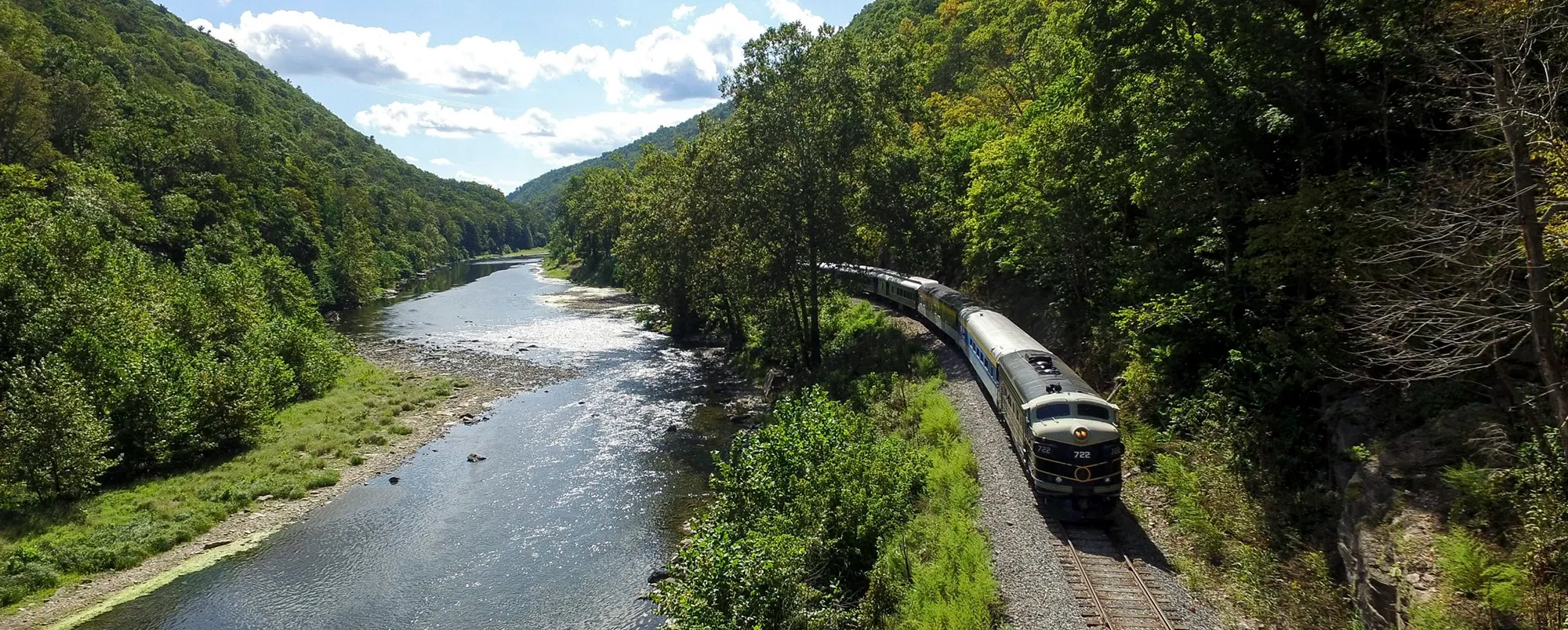
It was a state Public Service Commission study that first suggested that a scenic excursion train would be successful on the South Branch Valley Railroad. From that study members of the Romney Business and Professional Organization began their effort to make the idea a reality. A few years lapsed before the Potomac Eagle became the company in charge of making the dream of a few a source of pleasure for many. And by coincidence that time frame was also when a few American bald eagles decided to make the Trough, a narrow passage the train tracks and the river share, a permanent home. In the fall of 1991, the Eagle Canon Passenger Car Company began operating the Potomac Eagle from a siding named Wappocomo Station just north of Romney.
And that’s before passengers get to the 6-mile Trough, where eagles almost always await train visitors. Sometimes passengers see one eagle, and then other trips provide visitors with the chance to see several. It’s not a guarantee to see America’s greatest symbol on the Potomac Eagle, but it’s a pretty good bet that passengers will see at least one. It’s almost as if they come out on cue to perform in all their spectacular style.
Text adapted from Hampshire Review‘s special Eagle Extra insert, August 2005
On this page we feature several articles about the history of the Potomac Eagle, graciously provided by the Hampshire Review:
Potomac Eagle History
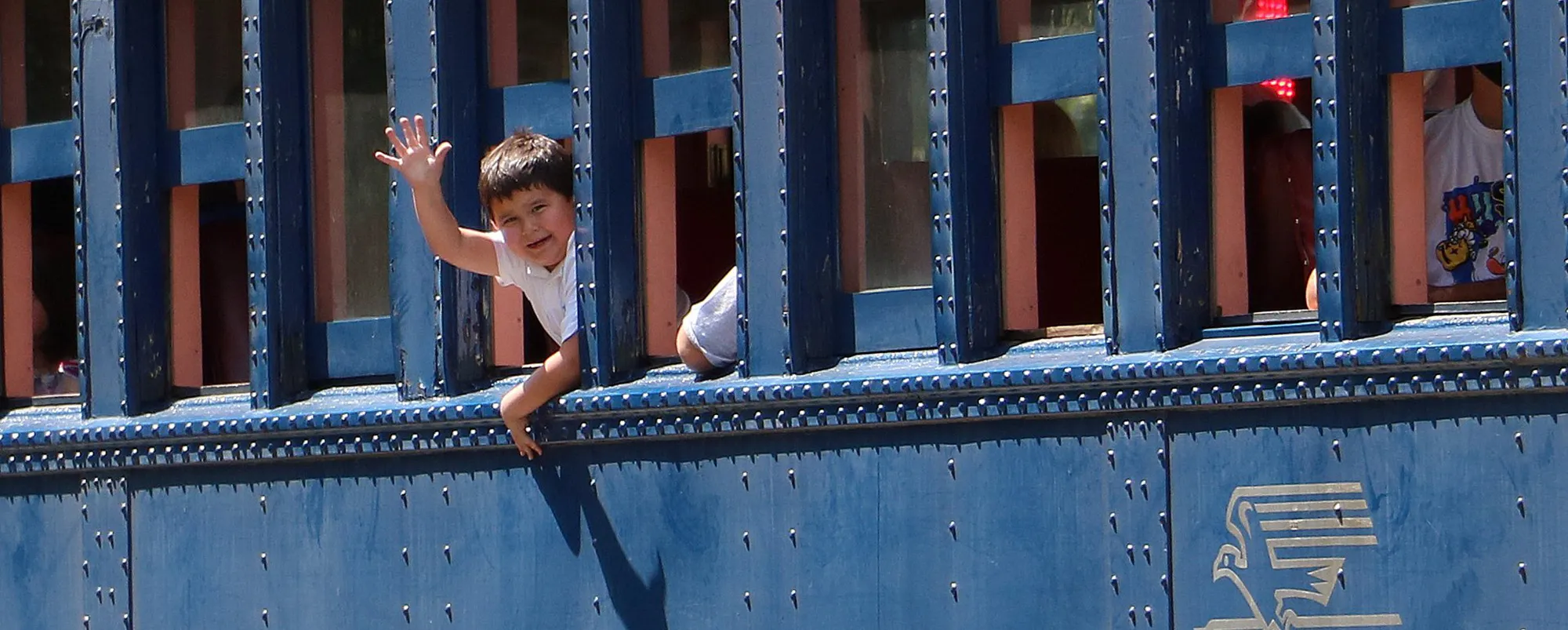
Most visitors on the Potomac Eagle are unaware of the long but storied past of the South Branch Valley Railroad. The line has been a vital part of the valley from Green Spring to Petersburg for well over 100 years. The South Branch Valley Railroad (SBVR) comprises a 52.4-mile route from Petersburg to Green Spring where it links to the CSXT mainline connecting Cumberland, MD to Martinsburg, WV. The SBVR generally parallels the South Branch of the Potomac River – from which the railroad takes its name. Crossing Hampshire, Hardy and Grant counties, the SBVR serves the towns of Romney (2002 population: 1,940), Moorefield (2002 population: 2,375) and Petersburg (2002 population: 2,423). The railroad is headquartered in Moorefield. It is owned and operated by the West Virginia State Rail Authority (SRA). State employees perform maintenance and freight operations.
But at least one early effort to build the line was futile. In 1875 a group of residents of Kanawha County, West Virginia formed a company designated the West Virginia Railroad Company. The group obtained authority to cross the state with a railroad which would commence on the Kentucky state boundary line and pass through Cabell, Wayne, Putnam, Kanawha, Braxton, Clay, Webster, Upshur, Randolph, Pendleton, Hardy and Hampshire counties. The line was supposed to extend to a point near the South Branch River near the Maryland state boundary line. The charter, which is on record in the Hardy County Clerk’s Office, discloses that the proposed railroad was to follow in a general course, the South Branch River through Pendleton, Grant, Hardy and Hampshire counties.
While those pioneers had the best of intentions and dreams, the smoke from a locomotive in Hardy County was still not to be seen for many years. In February 1880, a company called the Cumberland, Moorefield and Petersburg Railroad was organized to build a line between Green Spring and Petersburg. Little is known of the company other than they did not get their line built. However, on Sept. 1, 1884, a new company called the South Branch Railroad completed the line from Green Spring to Romney.
It was not until after the turn of the century that a rail line was built south of Romney. In 1909 construction started for a new company known as The Hampshire Southern RR. The company was headed by William B. Cornwell, brother of soon to be Governor John J. Cornwell. In 1910 the first trains providing freight and passenger service between Romney and Moorefield were operated on the new railroad.
This system was sold to the Moorefield and Virginia Railroad Company in 1911 with the purchaser assuming a mortgage existing against the line in the amount of $700,000. William Cornwell and Eugene Ailes, son-in-law of Governor Cornwell, were officers of the grantor company. In November 1913 the Moorefield and Virginia Company transferred the system to the Baltimore and Ohio Railroad Company. Passenger service was abandoned on the line sometime around 1928.
In the mid-1970s, the line was abandoned by the B&O. It was taken over by the State of West Virginia on October 11, 1978, as government officials became concerned over the harm that would come to existing industry and the prospects of driving away new business along the line. Track rehabilitation began on the 52-mile stretch, but the famous flood of 1985 knocked out four bridges and left 13 miles of track with heavy damage and 23 miles with moderate damage. It was reported that in some stretches in the Trough that rail and ties hung in mid-air with all traces of road bed gone beneath them.
Freight service operates five days a week, Monday through Friday, with special and unit train operations on weekends as needed. The SBVR’s largest customer is Pilgrim’s Pride in Moorefield. Pilgrim’s feed mill receives corn and other commodities used in the manufacture of its poultry feed. Nearly all of the corn arrives in 65-car unit trains which must be moved to the feed mill, unloaded and returned to CSXT in less than 48 hours. Three customers are located in Petersburg: Adell Polymers ships and receives loads of plastic pellets, Allegheny Wood Products ships finished lumber and Greer Lime ships outbound loads of lime. In 2004, the SBVR handled 4,243 revenue loads.
During its first ten years, the SBVR spent nearly $5 million on track improvements. In 1994, the railroad completed a $4 million bond-financed upgrade of its line. Since 1998, 25.6 track-miles of heavy, welded rail have been installed and over 46,000 crossties have been replaced. A major bridge program made it possible for the SBVR to raise its weight limit to 286,000 pounds per car. Three locomotives were upgraded with microprocessor controls to increase their tractive effort and save fuel. Three additional locomotives were purchased to help move the heavy unit trains over the steep grades between Green Spring and Romney. Plans are in place to continue with capital improvements for the next several years. The improvements will include additional welded rail, crossties, ballast and roadbed widening. There will be additional work on bridges to maintain their capacity.
By saving the South Branch Valley Railroad from abandonment in 1978 and rebuilding it following the flood of 1985, the State Rail Authority not only protected existing industry – and the estimated 2,600 jobs that relied on railroad service in the region – but also made possible its growth. Without the railroad, it is extremely doubtful that the more than 1,900 new jobs created by the region’s poultry industry during the past several years would have ever occurred.
In late 1989 the Romney Business and Professional Organization began a successful effort to bring a tourist train to the area. Spurred on by a state commissioned report showing the line had great potential, the group worked tirelessly to get the excursion up and running. With Delegate Jerry Mezzatesta spearheading the project in Charleston, the state capital, the spring of 1991 saw the first Potomac Eagle pull out of Romney. For some areas trains are a part of history, never again to be alive with the clanking of the cars rolling along. But for one small valley in West Virginia, the train industry could very well be just in its infancy.
Text adapted from Hampshire Review‘s special Eagle Extra insert, August 2005
The History Of The 722 Engine
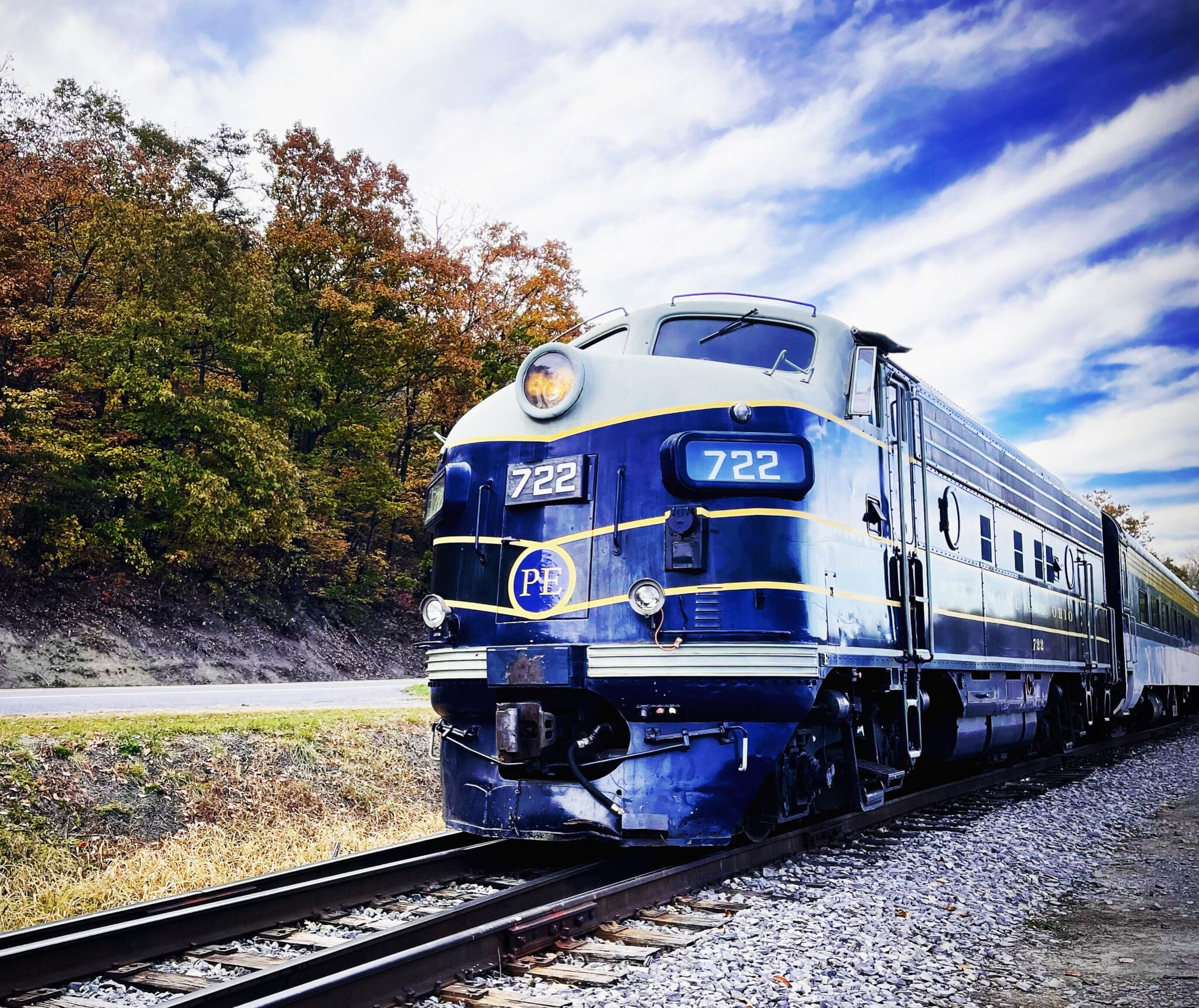
Big train engines seem to bring out the little boy in many men. Maybe it’s the power that seems to rumble through men’s souls when they spot the engine idling at the station; or maybe it’s just the enormity of the locomotives. But for whatever reason, railroad locomotives are certainly memorable. The Potomac Eagle #722 locomotive has a long and storied past. While looking for a door to fit a former CSX 116 as part of a grant project to restore a locomotive for the C&O Historical Society, David Corbitt, then-president of the Potomac Eagle Scenic Railroad, and Charlie Sayre, retired CSX locomotive engineer, discovered an F-7 locomotive in a Youngstown, Ohio salvage yard. Corbitt was in one part of the salvage yard looking for a door while Sayre was looking in another area. Sayre spotted the 1952 locomotive and urged Corbitt to take a look.
A short time later a deal was struck for the locomotive with LTE Rail Services, owners of the F-7. Potomac Eagle Scenic Railroad employees worked with LTE’s staff to make the repairs. Lettering for the Potomac Eagle’s name was performed and a target date of September 1, 2002, was set for the locomotive to arrive at Wappocomo Station in Romney. On August 30 Potomac Eagle’s restored #722 arrived at the CSX yards in Cumberland, Md. and on August 31 it was turned around and moved to Green Spring, W. Va. Potomac Eagle engineer Craig Yokum moved the locomotive to Wappocomo Station on September 1. #722 remained in the Potomac Eagle paint scheme until 2010 when it was repainted into B&O prior to the South Branch Valley Railroad’s 100th anniversary event in Petersburg.
The F-7 was built new in 1952 for the Bessemer and Lake Erie Railroad. It was part of the first wave of new diesel locomotives to replace steam engines. The 722 was built by Electro Motive Division of General Motors Corporation in La Grange, Illinois. After approximately 25 years of general service hauling coal, coke and iron ore between the Great Lakes and Pittsburgh, the unit became part of a small program that would extend the unit’s useful life on a Class 1 carrier. The unit was retrofitted for special remote control operation involving the B&LE’s dock facility in Conneaut, Ohio. Only a freak accident in August 2000 kept the unit from being one of the few to reach 50 years of service with the original owner.
Vintage Club Cars
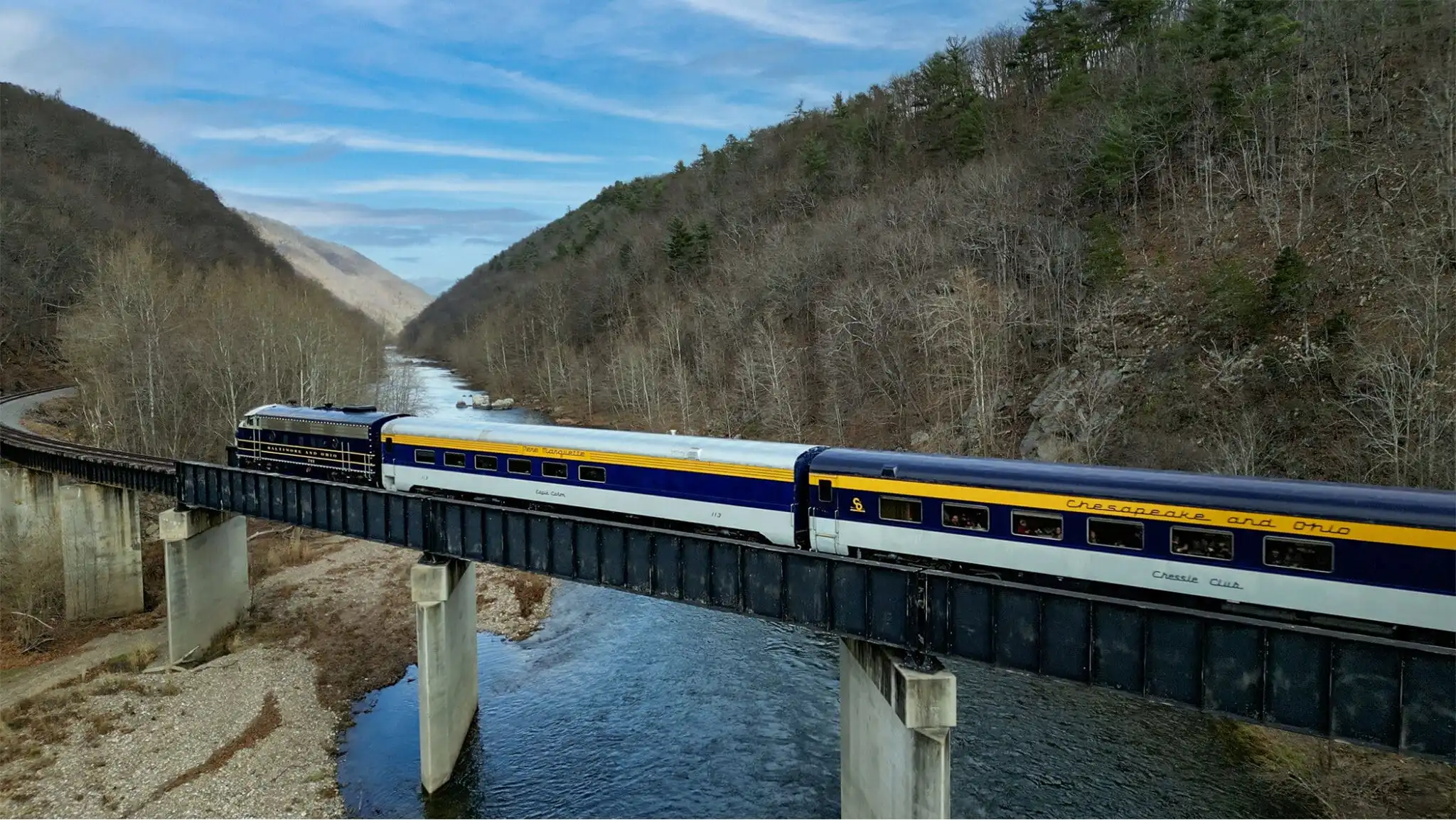
They’re not like the cars we drive, where a trade-in every few years is many times the norm. Rather, these cars are often decades old, and even a half century or more in service is not unusual. Yet, maybe that’s the draw to trains. If the cars were new, then they would have to be equipped with all the modern gadgets: e-mail, computers, cell phones, televisions, instant replay and all that. The folks at the Potomac Eagle would like to introduce you to two of their dining cars and let you in on a little history of them along the way. Here goes.
Built in 1950 by Pullman-Standard Car Manufacturing Company of Chicago, Ill., Pullman Car Works and ordered in 1946 by the Pere Marquette Railroad of Michigan, this lunch counter, buffet-bar lounge car was modeled after floor plan #7596. By the time of delivery in 1950, the Chesapeake and Ohio Railway had gained control of the Pere Marquette Railroad and sold three of the four cars in this series to the Denver & Rio Grande Western Railroad of Colorado: the Castle Gate #1290, Eagle Canon #1292 and the Royal Gorge #1291.
This series was unusual from the start as two cars were of PM design (the Eagle Canon and the Royal Gorge) and two of C&O design, the Chessie Club and the Castle Gate. The only car kept by the C&O was the #1903 Chessie Club, which became a one-of-a-kind on the rail line. The cars, although from the same order, had many differences based on the standards of the two railroads – Pere Marquette and C&O. The Pere Marquette style had smaller windows, 32-volt direct current and push doors. The C&O style had bigger windows, a 64-volt system and sliding doors. The three cars that went to D&RG Western Railroad of Colorado ran on the Royal Gorge Train until 1967 when the service was discontinued.
The two PM-designed cars went to the PRR as #1148 and #1149 becoming Penn Central 4448 and 4449. The cars Royal Gorge and Eagle Canon lost their names at this time and worked primarily as lounge cars on various named trains on the Northeast Corridor between New York and Washington and later on to Boston. The Castle Gate D&RGW #1290 was sold in 1967 to the Delaware & Hudson Railway and was renamed Champlain. This car went on to become part of the Guilford Rail System business car fleet in the Northeast where it remains to this day.
With the start of Amtrak in 1971 the Chessie Club, Eagle Canon and Royal Gorge returned to one owner, Amtrak, as Amtrak numbers 3360, 3361 and 3362. The only car that kept its name was the Chessie Club. Amtrak service came to an end in 1976, and the cars were auctioned at Amtrak’s Beech Grove Shop in Indianapolis, In.
In 1978 the Eagle Canon Passenger Car Company of Parkersburg, W.Va. purchased #3361 in the Amtrak bid. First sending the car to the SBVR in Moorefield, W.Va. and in 1981, sending it to Jackson, Ohio’s Jackson Iron and Steel Company’s (JISCO) facility for rebuilding. Following an ownership change, #3361 was sent to the Parkersburg Steel Company in Parkersburg, W.Va. in 1982 to finish the rebuild. In March 1983, Eagle Canon was attached to the rear of Chessie System train #204 for the trip to Benwood and on to Pittsburgh, PA for the Maple Sugar Excursions from B&O’s Grant Street Station in Pittsburgh to Meyersdale, PA. on B&O lines.
This was the beginning of a long run of excursions and special car operations that has seen Eagle Canon operate on Amtrak trains including into New York City on the high speed Northeast Corridor. The car has also been to many Kentucky Derbies, NASCAR races, mainline steam excursions, commuter service in the Boston area as well as numerous corporate events, throughout the United States.
A few years later the Chessie Club was awarded to ECPX, and after a similar rebuild, including re-siding, has joined Eagle Canon in excursion service. The 1903 along with 113 has been throughout the United States and Canada for those very special events where a rail car is required. Chessie Club has been seen on the rear of a Toronto-bound VIA train Sarnia, Ontario and on the rear of Amtrak #50, the Cardinal east of Huntington, WV.
Here’s a look at some of the various steam locomotives Eagle Canon cars have operated behind: C&O 2716; HV 33; Chessie 2101; NKP 765; C&O 614; UP 844; Cotton Belt 819; GSMRY 1701; N&W 1218; N&W 611; PM 1225; Frisco 1522; L&N 152; CP 2839; AT&SF 3751; JISCO #3; and MILW 261. The rebuild of these cars has been a ground up restoration and modernization that has allowed them to continue to operate to this day. The cars have independent power plants and holding tanks, plus updated electrical systems that allow the cars to operate independently anywhere standard rail reaches throughout North America.
Text adapted from Hampshire Review‘s special Eagle Extra insert, August 2005
Caboose History
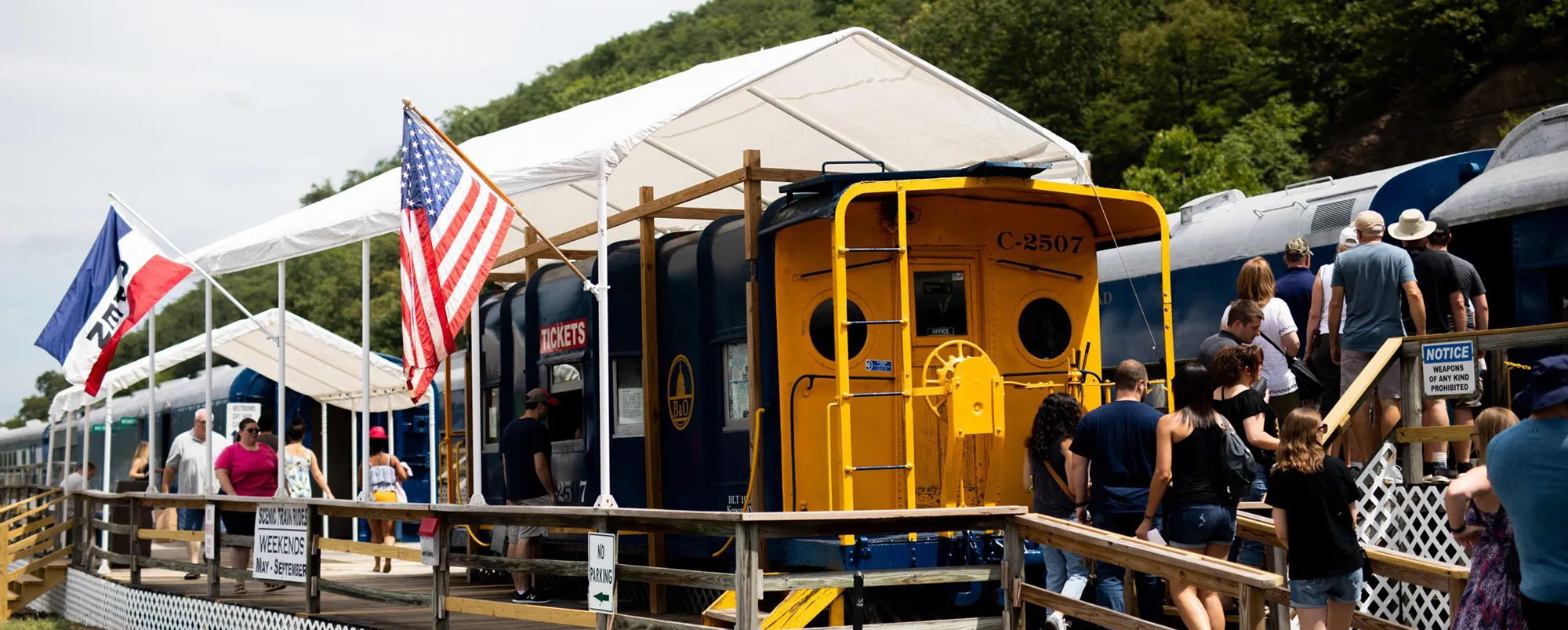
The origin of the railroad caboose has been the subject of much speculation and more than a few country songs along the way. It’s likely the first cabooses actually were freight cars temporarily used for housing the conductor and his staff of rear brakemen. Specialized cars assigned to members of the rear train crew and outfitted accordingly, cabooses began appearing in the United States in the mid-1800s.
After the Civil War, the Baltimore & Ohio built cabooses in significant numbers, most of which were four-wheel bobber cabooses, but a number of eight-wheel cars, which likely had been converted from box cars, were also in service.
By the late 1920s, Baltimore & Ohio’s caboose fleet had grown to over 1,200 cars. Almost all of these cars were of the standard cupola style, some of which were four-wheel cars, while others were eight-wheel types. But that would change drastically, and forever, with the building of one new caboose in 1930.
A single new caboose was constructed in 1930 at the B&O Railroad Company shops at Mount Clare, Baltimore. This new caboose was a radically different design from other cars then in service on American railroads. The new B&O car, numbered C2500, featured bay windows instead of the more traditional cupola. From that time forward, all B&O cabooses built new or converted, were of the bay-window design. B&O pioneered the concept, and other railroads picked up the style and built or purchased their own bay-window cabooses.
Bay-window cabooses were seen as having several advantages over cupola cabooses of the era. Their single level floor plan was considered to be safer, easier to heat in the winter and visibility of the train from the side bays was believed to be superior to observation from the cupola, especially since freight cars of the time were increasing in height and would effectively block the view from the cupola windows.
In 1935, a second bay-window caboose was outshopped from the Mount Clare shops. One additional caboose was completed in 1936. Between 1939 and 1940, five more cabooses were outshopped from the B&O shops at Cumberland, Md. All seven of these cars were experimental, bay window, wagon-top cabooses numbered C2501 through C2507.
These cars featured port-hole type end windows. They were the only B&O cabooses to utilize those type windows, and each had been converted from an older cupola caboose, whereas C2500 and C2501 were built new. The interesting wagon-top design was unique to the B&O, and the railroad eventually had box cars, covered hoppers and cabooses of the wagon-top style.
B&O caboose C2507, previously owned by the C&O Historical Society and currently by the Potomac Eagle, was built in 1940. Actually, C2507 was rebuilt from the underframe of an older class I-5 cupola caboose at the B&O shops at Cumberland, Md. It was the last of the seven experimental, wagon-top, bay-window cabooses. Approximately one year later, the B&O shops in Keyser began outshopping production wagon-top cabooses, number in the C2400 series and carrying caboose class I-12. Caboose C2507 continued in service on the B&O for over 40 years after its conversion in 1940. It was last painted in the red caboose scheme in the late 1960s at the B&O shops at Du Bois, Pa. Eventually, C2507 ended up in assigned service out of Cowen, W.Va.
In 1975 it was repainted an oddball Chessie System yellow scheme at the B&O shops at Grafton, W.Va. It finally was retired in the early 1980s at Cowen and sold to a private owner. The private owner did a partial renovation of the caboose before it was acquired by the Eagle Canon Passenger Car Company, which added the car as part of its depot in 1996. Of the original eight B&O experimental bay-window cabooses, three of the cars have been preserved.
In addition to the Potomac Eagle’s C2507, sister cars preserved include C2506, which is located at the B&O Railroad Museum in Baltimore, Md., and C2504, which is located at Davis and Elkins College in Elkins, W. Va.
